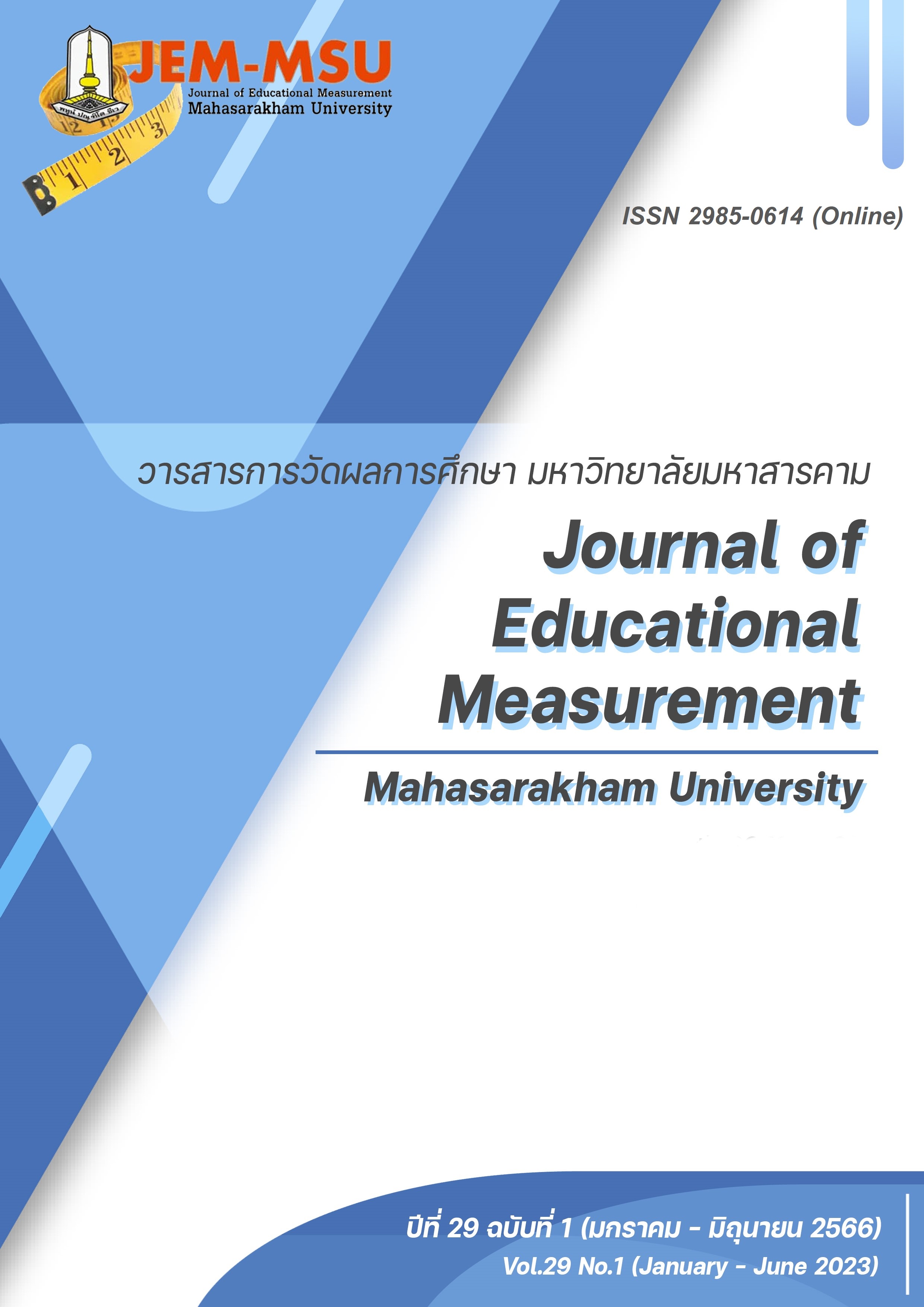การเปรียบเทียบคุณภาพของการตรวจให้คะแนนของแบบสอบอัตนัยวัดความสามารถในการแก้ปัญหาทางคณิตศาสตร์ ที่ใช้การออกแบบการตรวจให้คะแนนที่ต่างกัน: การประยุกต์ใช้ทฤษฎีการสรุปอ้างอิงความน่าเชื่อถือผลของการวัด
Main Article Content
บทคัดย่อ
การวิจัยครั้งนี้มีความมุ่งหมาย 1. เพื่อศึกษาคุณภาพการตรวจให้คะแนนแบบสอบอัตนัยวัดความสามารถในการแก้ปัญหาทางคณิตศาสตร์ของผู้ตรวจให้คะแนนภายใต้รูปแบบการตรวจให้คะแนนต่างกัน 2. เพื่อศึกษาขนาดของแหล่งความแปรปรวนขององค์ประกอบและค่าสัมประสิทธิ์การสรุปอ้างอิงของคะแนนแบบสอบอัตนัยวัดความสามารถในการแก้ปัญหาทางคณิตศาสตร์ เมื่อจำนวนผู้ตรวจ และรูปแบบการตรวจให้คะแนนแตกต่างกัน 3. เพื่อเปรียบเทียบค่าสัมประสิทธิ์การสรุปอ้างอิง (G-Coefficient) ของแบบสอบอัตนัยวัดความสามารถในการแก้ปัญหาทางคณิตศาสตร์ ภายใต้รูปแบบการตรวจให้คะแนนต่างกัน และจำนวนผู้ตรวจต่างกัน กลุ่มตัวอย่างในการวิจัยเป็นนักเรียนชั้นมัธยมศึกษาปีที่ 3 จำนวน 132 คน ได้จากการสุ่มแบบ 2 ขั้นตอน และกลุ่มผู้ตรวจ ให้คะแนนซึ่งเป็นครูผู้สอนวิชาคณิตศาสตร์ จำนวน 3 คน ได้จากการเลือกแบบเจาะจงเครื่องมือที่ใช้ในการวิจัย คือ แบบสอบอัตนัยวัดความสามารถในการแก้ปัญหาทางคณิตศาสตร์ ประกอบไปด้วยข้อสอบจำนวน 3 ข้อ มีค่าความยากตั้งแต่ 0.22 – 0.69 และค่าอำนาจจำแนกตั้งแต่ 0.56 – 0.80 ผลการวิจัยพบว่า 1) คุณภาพของการตรวจให้คะแนนแบบสอบอัตนัยวัดความสามารถในการแก้ปัญหาทางคณิตศาสตร์ ผู้ตรวจให้คะแนนคนที่ 1 มีความเห็นพ้องในการตรวจแบบสอบเมื่อเทียบกับเกณฑ์การตรวจให้คะแนนข้อที่ 3 มากที่สุด ผู้ตรวจให้คะแนนคนที่ 2 มีความเห็นพ้องในการตรวจแบบสอบเมื่อเทียบกับเกณฑ์การตรวจให้คะแนนข้อที่ 1 และ 2 มากที่สุด ส่วนผู้ตรวจให้คะแนนคนที่ 3 มีความเห็นพ้องในการตรวจแบบสอบเมื่อเทียบกับเกณฑ์การตรวจให้คะแนนทั้ง 3 ข้อน้อยที่สุด และความเที่ยงในการตรวจให้คะแนนระหว่างผู้ตรวจ (inter rater reliability) มีความสอดคล้องกันในระดับดีมาก 2) แหล่งความแปรปรวนในแต่ละรูปแบบการตรวจให้คะแนน รูปแบบการตรวจให้คะแนนแบบ P x I x R แหล่งที่มีความแปรปรวนมากที่สุดคือ PI และแหล่งความแปรปรวนที่มีค่าน้อยที่สุดคือ PR และรูปแบบการตรวจให้คะแนนแบบ P x (I : R) แหล่งที่มีความแปรปรวนมากที่สุดคือ PI : R และแหล่งความแปรปรวนที่มีค่าน้อยที่สุดคือ PR 3) รูปแบบการตรวจให้คะแนนที่มีค่าสัมประสิทธิ์การสรุปอ้างอิงสูงที่สุดคือรูปแบบ P x I x R และจำนวนผู้ตรวจ 3 คน ผลการตรวจมีค่าความเที่ยงมากกว่าผู้ตรวจ 2 คน
Article Details

This work is licensed under a Creative Commons Attribution-NonCommercial-NoDerivatives 4.0 International License.
เนื้อหาและข้อมูลในบทความที่ลงตีพิมพ์ในวารสารการวัดผลการศึกษา มหาวิทยาลัยมหาสารคาม ถือเป็นข้อคิดเห็นและความรับผิดชอบของผู้เขียนบทความโดยตรง ซึ่งกองบรรณาธิการวารสาร ไม่จำเป็นต้องเห็นด้วย หรือร่วมรับผิดชอบใดๆ
บทความ ข้อมูล เนื้อหา รูปภาพ ฯลฯ ที่ได้รับการตีพิมพ์ในวารสารการวัดผลการศึกษา มหาวิทยาลัยมหาสารคาม ถือเป็นลิขสิทธิ์ของวารสารการวัดผลการศึกษา มหาวิทยาลัยมหาสารคาม หากบุคคลหรือหน่วยงานใดต้องการนำทั้งหมดหรือส่วนใดส่วนหนึ่งไปเผยแพร่ต่อหรือกระทำการใดๆ จะต้องได้รับอนุญาตเป็นลายลักษณ์อักษรจากวารสารการวัดผลการศึกษา มหาวิทยาลัยมหาสารคาม ก่อนเท่านั้น
References
Koo, T. K., & Li, M. Y. (2016). A Guideline of selecting and reporting intraclass correlation coefficients for reliability research. Journal of Chiropractic Medicine, 15(2), 155-163.
Miller, M. D., & Legg, S. M. (1993). Alternative assessment in a high-stakes environment. Educational Measurement: Issues and Practice, 12(2), 9-15.
Aphaikawee, D. (2019). Improving the effectiveness of the subjective test scoring [Doctoral dissertation]. Khon Kaen University. (in Thai)
Bhu-iam, W. (2007). A comparison of generalizability coefficient and error variance between traditional and two-tier diagnostic tests In mathematics [Master’s thesis]. Chulalongkorn University. (in Thai)
Buasiripan, U. (2000). Comparison of reference sum coefficients of existing math tests. The methods of examination, the number of examiners, and the experience of the inspectors differ [Master’s thesis]. Srinakharinwirot University. (in Thai)
Chuithong, S. (2011). Model quality examination of the learning assessment toolkit based on actual conditions, mathematics learning subject group Mathayom 1 by applying the theory of reference summary [Master’s thesis]. Srinakharinwirot University. (in Thai)
Institute for the Promotion of Teaching Science and Technology. (2020). Mathematical Literacy. https://pisathailand.ipst.ac.th/about-pisa/mathematical-literacy/ (in Thai)
Inthanate, N. (2011). Characteristics of the open-ended mathematics test scores for Different numbers of raters and scoring patterns using Generalizability model and many-facet rasch model [Doctoral dissertation]. Srinakharinwirot University. (in Thai)
Kanjanawasee, S. (2012). New test theory (4th Ed.). Chulalongkorn University Press. (in Thai)
Prasertsinponma, D., & Tuksino, P. (2021). Comparison of results of subjective test for measuring mathematical competencies of primary 6: application of generalizability theory. The 22nd National Graduate Research Conference (Online Conference), 22(1), 398-408. (in Thai)
Saenpluem, B. (2013). Using the Characteristics Testing Method and the Proportion of the Number of Reviewers on the Accuracy of the Writing Ability Measurement of Grade 3 Students [Doctoral dissertation]. Srinakharinwirot University. (in Thai)
Sa-nguanwai, C. (2015). Comparison of the reliability of problem-solving ability tests mathematical creativity The application of summation theory references the reliability of measurement results [Master’s thesis]. Chulalongkorn University.(in Thai)
Tangdhanakanond, K. (2014). Measuring and evaluating practical skills. Chulalongkorn University Press. (in Thai)
Taoto, J., Jarernvongrayab, A., & Baikularb, P. (2016). A study of the reliability of mathematics essay test score for matayomsuksa 2 students: The different number of raters and scoring patterns using generalizability theory. Hatyai Journal, 14(1), 1-14. (in Thai)
Thitikanpodchana, W., & Tuksino, P. (2021). Comparisons of the Results of Essay Test by Different Scoring Designs: Application of Generalizability Theory. The 22nd National Graduate Research Conference (Online Conference), 22(1), 409-418. (in Thai)
Tuksino, P. (2013). Teaching documentation Educational research methodology. Faculty of Education, Khon Kaen University. (in Thai)
Umnacil, M. (2014). Comparison of reliability of modified essay question test for measuring Scientific problem solving ability using different scoring methods Under different numbers of event: An application of generalizability theory [Master’s thesis]. Chulalongkorn University. (in Thai)

